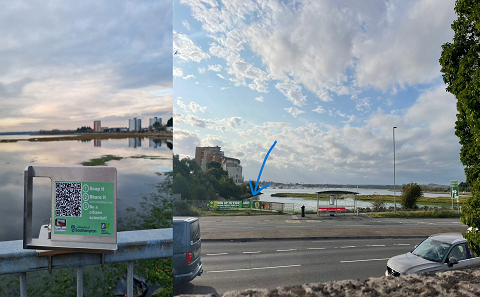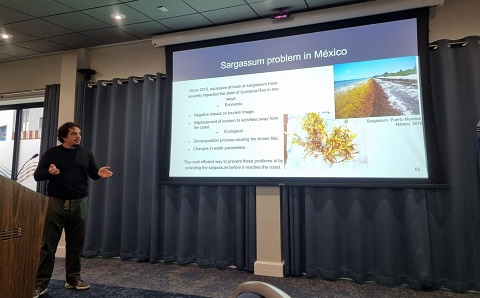Multistakeholder conference in Poole explores what we do and do not know about local seaweed influxes

For the past 6 months, University of Southampton researchers have been working with students from the Cornerstone Academy to better understand the green ulva seaweed that regularly inundates Poole Harbour.
This builds on past work led by Dr Sien van der Plank on methods to involve young people in the research of coastal change, and of Dr Victoria Domginuez Almela on seaweed bloom events globally.
The NERC-funded Poole Together project brought together secondary school students with diverse stakeholders concerned about the increasing ulva macroalgal (seaweed) blooms in Poole Harbour.
A team of University of Southampton researchers explored with partners how a citizen science photo method can increase data on ulva; raise awareness to its social, economic and environmental impacts; and identify opportunities for adaptation to this “new normal”.
All this hard work culminated with the team, led by the University of Southampton, hosting a half-day conference on 20 February 2024, at the RLNI College in Poole. Attendees included a diverse range of stakeholders including the Cornerstone Academy students and teachers, local authority coastal management and conservation teams, utilities, ocean charities, and researchers from multiple south coast universities.

The conference was headlined by eleven Cornerstone Academy students presenting their work, both through their poster, “The Stinky Truth: Uncovering the Secrets in Holes Bay”, and a live presentation to describe what they learned and researched through an ulva after-school science club. As part of their presentation, the students showcased the citizen science monitoring station they helped set up to study the seaweed in Holes Bay. The monitoring point forms part of the global CoastSnap citizen science network, enabling anyone to stop, take a photo, and share it through the app or social media to an open access repository to monitor shoreline (and seaweed) change. The students were instrumental in both the design of the accompanying information sign and site selection, adjacent to Poole Station.

The remainder of the conference sessions focused on two aims. First, stakeholders gave brief presentations from their specialist / interest areas to share what we already know about ulva and related subjects in the Poole Harbour area. This included content on the causes and impacts of ulva, the relationship between ulva and other species in Poole Harbour, and methods to study and manage nutrients and ulva. Most presentations focused on ulva and other local work, but Jose Antonio Lopez Portillo Hurtado (visiting researcher University of Southampton) shared his research on sargassum seaweed in Mexico and how the methods could be transferred for the study of ulva. Second, the attendees discussed what we need to know about the topic, with an hour’s session to discuss research priorities, policy and management needs, and how we can better involve the public and other stakeholders in the process. The conference has thus hopefully become the beginning of many new collaborations and partnerships.
The Poole Together project was supported by UKRI NERC Grant GR308.